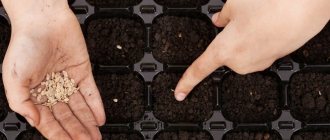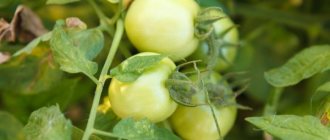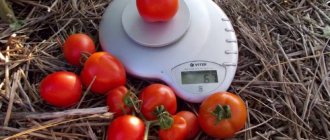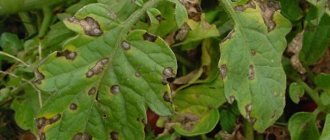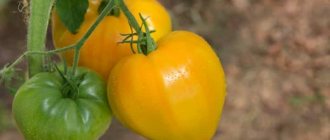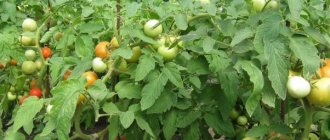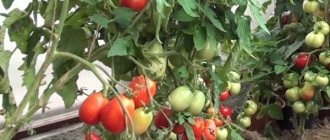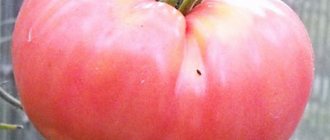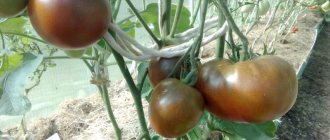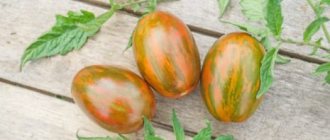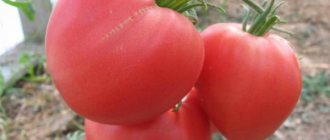» Vegetable growing » Tomatoes » Tomato variety Japanese dwarf
0
1095
Article rating
The Japanese dwarf tomato is a compact variety that can be grown not only in the garden, but also in a flower pot. The plant is unpretentious and rarely gets sick, calmly tolerates lighting restrictions, and is content with a small area of land. To get a good harvest, it is useful to know the characteristics of this variety and the rules of agricultural technology.
- Advantages and disadvantages
- Landing
- Transfer
- Care
- Gardeners' opinions
Tomato variety Japanese dwarf
Description of the variety
Japanese dwarf is a tomato variety that got its name due to its short stature . This tomato is in no way connected with Japan, as it was bred by Kazakh breeders.
Despite the fact that this variety was bred a long time ago, it is difficult to find it on Russian markets . It is produced by . However, the advantage is that the seeds of its fruits are used for further growing tomatoes; it is not necessary to buy them every year.
Note! The Japanese dwarf tomato is often confused with the Mongolian dwarf variety. These are different varieties with different characteristics.
Distinctive features of the Japanese dwarf
The main feature of the Japanese dwarf is the short stature of its bush. The plant reaches a height of only 30-55 cm.
The fruits of this variety are the most common. They are small and round . They are red in color and have dense but tender flesh. Read more about the appearance of the fruit in the photo.
taste for early-ripening tomatoes - rich, sweet with a slight sourness.
Another positive feature of this tomato is its ease of care. It is resistant to temperature changes and is able to grow in shaded areas. Thanks to this, its cultivation is possible in summer cottages.
The Japanese dwarf yields its harvest in the first half of summer . Thanks to this, he does not have time to get late blight. This variety has average resistance to other diseases characteristic of nightshade crops.
During the fruiting period, the plants look very decorative . The bushes take on a spherical shape and are covered with a large number of bright red fruits.
Care
Japanese dwarf bushes do not require obligatory shaping, but to increase productivity it is recommended to remove their lower stepsons. Shoots growing from the ground do not bear fruit, but the root system consumes nutrients on them.
():
If the plants are grown indoors (on the balcony), there is no need to remove the stepsons. These stepsons are not formed by chance. Tomato is by nature a perennial plant. Over time, the main stem, having bear fruit, dies, and fruiting passes to the lateral stepsons. In room conditions with a constantly positive temperature and good lighting, a tomato can grow and produce crops for several years.
Despite the low growth of the bushes, it is better to tie them up, since the graceful stem is not always capable of holding a whole cluster of fruits.
During the growing season, tomatoes are watered every 10 days, and during flowering and fruiting - weekly.
After watering, the soil in the garden bed is loosened, providing the roots with access to air and nutrients.
Fertilizing is done once a week using mineral and organic fertilizers. During the growing season, the complex should include nitrogen fertilizers, and during flowering and fruiting - phosphorus and potassium.
As necessary, the beds are weeded from weeds and watered with an ash solution, thereby preventing pests and diseases.
Japanese dwarf tomato
TREPELLING TOMATO MONGOLIAN Dwarf. Olga Chernova.
Tomato Mongolian Dwarf: the productivity of this variety is legendary!
Growing seedlings
Seedlings of early ripening tomatoes begin to be grown 50-60 days before they are planted in a permanent place. Japanese dwarf is grown mainly in open ground.
The timing of sowing seeds for seedlings will differ for different regions.:
- southern - early March;
- central – second half of March;
- northern - early April.
When growing tomatoes at home in pots, the timing of sowing seeds does not matter.
Tomato Mongolian dwarf: planting and care
In general, the agricultural technology for growing the Mongolian dwarf tomato differs little from the agricultural technology for growing other varieties of tomatoes, but there are also important features.
The key point is the choice of growing method (in open ground, in a greenhouse or containers) and the timing of sowing the seeds.
Choosing a growing method
It is believed that the Mongolian dwarf tomato does not grow well in a greenhouse; excessive humidity and high temperatures cause the plants to lose flowers and ovaries, and the fruits to crack.
At the same time, there are many reviews on the Internet about the successful cultivation of Mongolian dwarf tomatoes in a greenhouse, in the “legs” of tall varieties. This method of growing allows you to plant more plants in the greenhouse. To make sure that such planting is possible, you need to conduct an experiment in your own growing conditions. In any case, when growing tomatoes in a greenhouse, it is necessary to ensure ventilation. We grew this variety in open ground. This variety can be planted in 2 ways: through seedlings and direct sowing in the ground.
The seedless method can be grown in the presence of a “warm bed” or in regions with a hot climate.
Seeds for seedlings are sown 55-60 days before planting the seedlings in the ground. The timing of sowing seeds for seedlings can be from February to obtain the earliest possible harvest and until the beginning of May.
For those gardeners who do not have the opportunity to grow seedlings at home, late sowing of Mongolian dwarf tomato seeds allows them to use greenhouses and greenhouses for this purpose; of course, in this case there is no need to expect an early harvest.
The peculiarity of the variety is that the seedlings do not stretch, and already during this period the plants are compact in size. When planted in the ground, they reach 10 cm in height.
Growing in open ground
It is advisable to plant seedlings in the ground in a checkerboard pattern at a distance of at least 60-80 cm between plants. Plants of this variety take up a lot of space; closer planting interferes with the ventilation of the plants.
After planting, the soil should be mulched with straw, small twigs, rotted sawdust and other organic matter. Mulching insulates the fruits from the soil surface, helps retain moisture and fight weeds.
In the description of the Mongolian dwarf they write that he has powerful developed roots, but this is not so. Their root system is superficial and does not go deep. Therefore, despite the declared unpretentiousness and resistance to drought, there is no need to create unnecessary stress for the plants. The variety requires watering, but excessive watering is not necessary so that the tomatoes lying on the ground do not rot.
Further care as usual: fertilizing, preventive treatments for diseases.
Formation of the Mongolian dwarf bush
Formation of plants - removal of stepsons of the Mongolian dwarf tomato is not required. The crop is planted on the stepsons, so if the bush is very thick, you can only remove a small part of the stepsons so that it is better ventilated.
In conditions of short summer in August, it is advisable to remove the crown of the plants (pinch) and the last flower clusters. Limiting the growth of the plant will allow the already formed fruits to ripen normally. It is also recommended to gradually cut off the leaves on the bushes at the end of summer. This technique promotes faster ripening of fruits and the prevention of fungal diseases.
When cold weather sets in, you can easily install a “hut” with film or covering material over the plants to prolong fruiting.
Mongolian dwarf tomatoes are very popular with slugs. Therefore, when growing this variety, you need to monitor the appearance of pests.
Seed preparation
Most gardeners purchase Japanese dwarf seeds from their fellow hobbyists. Such planting material must be checked for germination . To do this, soak it for half an hour in a glass of water with the addition of 1 teaspoon of salt. Floated specimens are collected and thrown away. The seeds that have sunk to the bottom are washed and used for planting.
Planting material must be disinfected. To do this, it is soaked for 20 minutes in hydrogen peroxide or a light pink solution of potassium permanganate.
Another option is soaking in a growth stimulant . Use “Sodium Humate”, “Epin” or “Zircon”. As folk remedies that accelerate the germination of planting material, use water with honey, soda solution or aloe juice.
Preparation of soil mixture and selection of containers
For tomato seedlings, choose light but nutritious soil . Suitable compositions are sold in specialized stores, but most gardeners prefer to prepare the soil themselves.
There are many ways to prepare soil for tomatoes. The list contains several good options :
- Equal parts of black soil and peat are mixed. Add 0.5 parts of humus and 1 part of river sand to the resulting composition. Take 10 g of ammonium nitrate and potassium chloride per bucket of the resulting mixture.
- For 3 kg of peat, take 1 kg of sawdust, 0.5 kg of mullein and 1.5 kg of river sand. For this amount of soil mixture, take 5 g of ammonium nitrate and potassium chloride, as well as 10 g of superphosphate.
- Peat, humus, garden soil and sawdust are mixed in equal proportions. For a bucket of mixture take 1.5 tbsp of ash, 1 tbsp. l potassium sulfate, 3 tbsp. l superphosphate and 1 tsp urea.
The soil for tomatoes needs to be disinfected. To do this, it is calcined in the oven or poured with a dark pink solution of potassium permanganate.
To sow seeds, take large shallow containers . They use both special trays, cassettes and boxes, as well as improvised means.
For picking plants, use any deep containers with a volume of at least 300 ml. Drainage holes are made at the bottom of homemade pots.
All dishes for sowing seeds are disinfected - soaked in a dark pink solution of potassium permanganate.
Sowing seeds
Japanese dwarf is an inexpensive and unpretentious variety . More often it is grown by sowing seeds in one large container and then planting them in individual pots.
Soil is poured into the seedling box . The soil is watered abundantly and leveled. Make grooves 1 cm deep at a distance of 2-3 cm from each other. Seeds are placed in them at intervals of 2 cm.
The seeds are covered with soil. The containers are covered with film and placed in a warm place with a temperature of 24-26 ºC.
Rules for caring for seedlings
Growing tomato seedlings is not difficult . You just need to follow the basic rules for caring for it:
- When the first shoots appear, the film is removed from the boxes. They are moved to a well-lit place. Experienced gardeners recommend that after seed germination, place the seedlings in a room with a temperature of 17 ºC for a week. The plants are then placed in a warm place. This will prevent the tomatoes from pulling out prematurely.
- Water the tomatoes with warm water. Water should not fall on the above-ground part of the plant. The frequency of watering depends on the rate of drying of the soil.
- When real (not cotyledon) leaves appear, the tomatoes are dived into separate pots. A layer of drainage is placed at the bottom of the containers. There is no need to pinch the roots of the plants.
- It is fed 3 times during the period of growing seedlings. The first time 2 weeks after picking into individual containers, the second time 14 days after the previous feeding, the last time 5 days before planting tomatoes in open ground. Use complex fertilizers or vermicompost.
- Hardening off tomatoes will allow them to quickly adapt to open ground conditions. To do this, the seedlings are taken outside every day for several hours. The procedure begins 2 weeks before planting the tomatoes in a permanent place.
Features of cultivation - planting and care
Growing tomatoes begins with sowing seeds for seedlings. The best period for this is March 20 - April 5. You can successfully sort the seeds in a solution of table salt. You can throw away any planting material that floats to the top within 5 minutes - it will not produce high-quality seedlings.
The seeds that have sunk to the bottom are washed and prepared for planting. To get rid of pathogens, soak the material for sowing in a weak solution of potassium permanganate for 30 minutes, after soaking, rinse again and lightly dry.
- The planting box is filled with earth, its surface is leveled and moistened.
- Every 4-5 cm, grooves 1 cm deep are cut with a suitable tool.
- The seeds are placed at a distance of 1 cm from each other and sprinkled with soil.
- A film shelter is built on top and the boxes are moved to a warm place with a temperature of about 25°C.
- As soon as the shoots appear, the film is removed and the boxes with seedlings are moved to the brightest possible place.
- Seedlings are picked after the appearance of 2-3 true leaves. Each plant is carefully moved into a pot with a diameter of 9-12 cm.
https://www.youtube.com/watch?v=EJtTSyTxTAg
Planting in open ground occurs as soon as the threat of frost has passed. As a rule, this occurs at the end of May or beginning of June. This can be done a little earlier if the plantings are under film cover.
During the growth process, the Mongolian Dwarf bushes are watered as needed, avoiding sudden changes in soil moisture, which can adversely affect the quality of the fruit. After watering, the soil needs to be loosened so that a hard crust does not form.
To increase the amount of harvest, do not forget to apply fertilizing. The plants are fertilized for the first time 2-3 weeks after planting in the ground. The next two feedings will need to be done during the period of fruit ripening.
Japanese dwarf is an unpretentious variety, but this does not mean that tomatoes grow successfully on their own. Tomatoes require at least minimal care.
Formation
Japanese dwarf tomatoes are determinate, but not super low-growing. They grow half a meter from the ground, sometimes even a little higher. When the plant reaches its maximum height, it terminates (stops growing). The secret to getting a normal harvest from this tomato lies in the correct formation of the bush.
For proper formation, approach the bush once during the entire season - at the very beginning, when the first brush blooms. It is required to pluck out all the side branches (stepchildren) below the flower brush, making sure to leave small stumps.
No more shoots will grow here. In addition, all the growth that has emerged from below at the base of the main trunk is immediately removed. That's it, the work is finished. The side shoots that will grow above the first brush are left. Plants must be tied up.
Agricultural technology of the Japanese dwarf
Japanese dwarf is planted in open ground when the soil temperature at a depth of 15 cm reaches 16 ºC. In the northern regions this happens in early June, in the central regions - in mid-May, in the southern regions - at the end of April.
It is possible to grow Japanese dwarf by seed in the southern regions . In this case, the fruits will ripen much later. Planting material is sown in open ground in early May. After sowing the seeds, the beds are covered with film.
About other varieties of tomatoes:
Unpretentious in care and generous in yield, the Tea Rose tomato
Tomato “Aphrodite f1”, beloved by gardeners in all regions of the country
Planting seedlings in a permanent place
In the fall you need to prepare tomato beds . They are dug up and cleared of cultivated plants and weeds. The soil is fertilized with mullein or humus. If the soil is highly acidic, dry lime is added to it.
In the spring, the tomato beds are dug up again . All formed plant roots are removed. The soil is treated with copper sulfate.
All tomatoes are light-loving plants. For them, it is better to choose the most illuminated place in the garden. The Japanese dwarf tomato can also grow in shaded areas.
Holes for the Japanese dwarf are dug in rows in a checkerboard pattern . The optimal planting pattern is 50x50. In this case, per 1 sq. m fits 5 plants. For this variety, thickened planting is also possible. For 1 sq. m, some gardeners place up to 9 plants. The yield in this case will be lower.
Pour 1 tbsp into the holes. l ash or long-acting granular fertilizers. A tomato is immersed there along with a lump of earth. The depression is filled with earth, which is compacted.
Each tomato is watered with 1 liter of water . The next watering will be possible in two weeks.
Tomato care
The Japanese dwarf tomato is small in size . It doesn't need to be tied up.
The instructions say that there is no need to form bushes of this variety . Experienced gardeners advise removing excess shoots. Otherwise, the yield of Japanese dwarf will decrease and the fruits will be small.
Water the plants as the soil dries out . Use 1.5-2 liters of water per bush. On average, 2 waterings are done per week. This variety also tolerates short droughts.
Foliar fertilizing is applied 2-3 times per season . Alternate organic and mineral compositions. Use products containing boron. They accelerate the formation of ovaries.
RULES FOR WATERING TOMATOES! SECRETS FROM OKTYABRINA GANICHKINA
The nuances of growing a Japanese dwarf
To get the maximum yield of Japanese dwarf tomato, you need to know several nuances of caring for it :
- It is necessary to adopt a Japanese dwarf. To do this, once during the entire period of its cultivation (when the first cluster blooms), all the stepsons located below the upper flower cluster are removed. You also need to remove all unnecessary growth. The shoots above the first brush are not removed.
- If the fruits of this variety lie on the ground, then to reduce the likelihood of diseases, place cardboard or plywood under them.
- To speed up the formation of ovaries, periodically shake the tomato bushes.
- Japanese dwarf beds need to be regularly cleared of weeds. The presence of weeds in the garden will negatively affect the condition of the tomato roots.
Diseases and pests
Japanese dwarf has moderate resistance to tomato diseases . It must be protected from fungal and viral pathogens.
Methods for preventing tomato diseases:
- Disinfect not only the soil, containers and planting material, but also garden tools.
- Regular weeding of the beds and removal of plant debris will prevent infection of tomatoes - weeds carry spores of viruses and fungi.
- Regular but moderate watering and loosening the soil. It is waterlogged soil with poor air exchange that creates ideal conditions for the development and spread of infections.
- Spraying tomato bushes with a solution of potassium permanganate. This remedy, harmless to humans, will protect tomato bushes from fungal infection.
- Protecting bushes from insects. Plants are sprayed with a soap solution or dandelion decoction. Large insects are collected from bushes by hand.
Advantages and disadvantages
The advantages include the following features of the variety:
- The short “dwarf” lies close to the ground, so even a strong steppe wind will not break it.
- The bushes do not require tying or pinching, which saves time and effort.
- The plant is particularly resilient: it can easily withstand sudden changes in daily temperature, insufficient amounts of irrigation water, temporary drops in temperature and an abundance of morning dew.
- Tomatoes of this variety rarely suffer from late blight. And if they are affected, it is weakly and only late in the fall, when the cold weather has already begun.
- Early ripening and long fruiting period: from the beginning of summer until the first frost.
- High yield: up to 10 kg can be harvested from one bush.
Find out how to choose tomatoes to grow.
There are few disadvantages, but they exist:
- "Dwarf" does not like acidic, heavy soils. It will not give a good harvest in areas with a humid climate, where it is very hot.
- The initial phase of development is very drawn out: at first the seedlings “sit” for a long time, and then suddenly begin to grow in breadth.
- “Mongolian Dwarf” is not listed in state registers, so it is impossible to buy it in stores.
Features of cultivating Japanese dwarf at home and in the garden
Japanese dwarf is rarely planted in greenhouses . They are resistant to temperature changes and are able to grow in open ground even in northern regions.
When growing tomatoes in open ground , for the first 2 weeks after picking, they are covered with film in the evening so that they do not die during night frosts.
In pots on the balcony, the method of growing tomatoes is no different from cultivating them in open ground. The lack of lighting must be compensated with fluorescent lamps.
Gardeners' opinions
Reviews about this tomato are not always clear. Most gardeners are satisfied with the compact size of the bushes and consider a yield of 1.5-2 kg to be quite acceptable.
According to others, fruit characteristics and yields are inferior in comparison with similar determinate varieties.
- The fruits correspond to the description: they are small, raspberry-red, smooth, completely round. Many housewives grow this variety specifically for preservation.
- Tomatoes receive positive reviews when grown indoors. Many consider them an excellent option for a mini-vegetable garden on a loggia or balcony. The bushes grow well and bear fruit in flower pots, without suffering from a lack of space and light. By planting them in pots in the fall, you can harvest fresh vegetables almost all winter.
- It is noted that the seeds of these tomatoes are not always available for free sale, but since the Japanese dwarf is not a hybrid, some people harvest them themselves.
Farmer reviews
Reviews about the Japanese Dwarf are good. This variety is loved by both beginners and experienced gardeners .
Galina, Yekaterinburg: “I have been growing Japanese dwarf in open ground for 5 years now. This is my favorite early ripening variety. Its small red fruits are very tasty. I plant one bed, so we eat all the tomatoes fresh. Very easy to grow. You only need to touch it once. I water it once a week.”
Irina, Kursk: “I took the Japanese dwarf from a friend. I really wanted to try growing an early ripening variety that requires minimal care. The tomato lived up to expectations. I felt great at the dacha, which I visited once a week. The first tomatoes ripened at the end of June. I liked the taste. I will plant more!”

